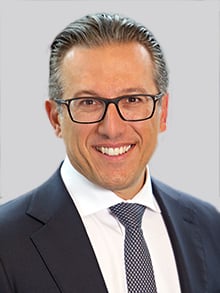
Financial year 2022 was dominated by several macroeconomic factors, which made for a challenging market landscape; albeit one with many opportunities for our investment teams.
While the geopolitical fallout from managing the Covid pandemic remained the dominant economic theme over the past 12 months, the second half of the financial year saw the headlines give over to the Russian invasion of Ukraine.
More broadly, these events have accelerated the shift away from the easy monetary policy and low inflation we have seen for the better part of the last decade, to a new regime of higher inflation, slower growth, monetary policy tightening, supply chain disruption and rising interest rates.
Inflation and volatility
We think, in the years ahead, markets will need to become accustomed to more inflation than previously experienced. This distinct shift in the macro backdrop is already playing out across asset classes.
Worries over inflation and interest rates are tempering valuations, including across growth equities, and the rout of more speculative assets, from crypto currencies to concept stocks, has served as a reminder of the importance of investing for the long term. These are unfamiliar conditions for many market participants and some investors will be experiencing volatile markets for the first time. Pleasingly, we have seen a range of our capabilities benefit from these conditions and we would like to take you through a few examples of how our investment teams are positioned for the new reality.
Value rotation
We have long believed that markets are poised for further rotation to a more value-oriented investment environment as Covid disruptions, waning stimulus and war combine to keep consumer price inflation at high levels.
Until June this year, equity markets were resilient in the face of the rate hikes, but bond markets have priced in tighter monetary policy much more aggressively. Historically, when the bond market and equity market disagreed, the bond market was usually correct.
In our view, rising bond yields will eventually lead overpriced growth stocks into a more sustained and overdue correction, challenging investors with large growth exposures. In these conditions our focus on value style investing, buying quality companies with strong balance sheets trading at reasonable valuations should continue to do well and offer attractive opportunities for investors.
Floating through rising rates
Bond markets have had a turbulent year, with yields rising sharply as markets price in increasingly aggressive central bank tightening to combat inflation. Domestic credit spreads have widened as a result, although these have been more resilient than offshore peers.
We believe that both economic activity and earnings growth remain supportive for credit spread resilience moving forward. In this environment, the floating rate exposure of many of our credit funds is key, and can offer regular income and protection against rising bond yields as, if interest rates move up, the portfolio benefits from an increase in interest payments.
Real returns
We were excited to announce earlier this year that Perpetual’s Diversified Real Return Fund was awarded.
Morningstar Australian Fund Manager of the Year: Multisector Category, 2022. The Fund is designed for investors looking for a smoother investment journey without sacrificing returns and is an option for those wanting some inflation protection in their portfolio.
The investment team applies a dynamic asset allocation approach to managing the Fund, which means they have the flexibility to actively shift the investment exposures to capture the best opportunities – wherever they are found.
Our ESG journey
Finally, the Perpetual Ethical SRI Fund celebrated its 20th birthday in April. The Fund aims to provide investors with a quality and value-focused portfolio of predominantly Australian ethical and socially responsible companies. The strategy is first and foremost an extension of Perpetual’s core investment process, but with additional Ethical and SRI screens, which allow exclusions based on specific unethical activities, while also identifying the performance of companies on a broader range of SRI factors.
Since the launch of this Fund 20 years ago, Perpetual Asset Management Australia (PAMA) has built out a suite of dedicated ESG investment strategies and most recently, access to the Fund was made available via an Active ETF, the Perpetual Ethical SRI Fund (Managed Fund) (ASX: GIVE).
Conclusion
As always, markets and conditions will continue to evolve. The last 12 months have seen a distinct shift in the landscape which few have been prepared for and which will challenge many investors. Through these times, our investment teams remain focused on investing for the long term, and preserving the capital of our clients, with our active investing approach well placed to take advantage of the opportunities ahead.
Viewpoints from our investment managers
Paul Skamvougeras- Head of Australian Equities
Michael Korber - Managing Director, Credit and Fixed Income
Michael O'Dea - Head of Multi Asset
Brad Kinkelaar - Senior Managing Director, Lead Portfolio Manager, Barrow Hanley Global Investors
 Australian Equities
Australian Equities
There was significant volatility in markets this year with the S&P/ASX300 accumulation index falling -6.7%. Our concerns last year about the “risks of more inflation than market consensus” have certainly been vindicated as the Australian economy began to feel the impact of rising cost pressures sweeping through the world economy. The invasion of Ukraine by Russia, the largest conflict in Europe since 1945, marked the most significant new shock for investors to contend with, with fears of energy and food shortages spiking as port blockages and sanctions threatened to choke global supplies of both commodities. Despite a broad sell off in global equities, the energy and mining-heavy Australian market held up relatively well, although there was significant rotation in stocks as policy settings changed.
For most of the past two years central bankers have firmly stuck to the idea that inflation was transitory. This position was gradually abandoned through the financial year as inflation remained elevated and policymakers began to worry that future inflation expectations might rise, becoming “unanchored” from their current low levels. This was accentuated by the economy nearing full employment and the risks of high inflation triggering a wage-price spiral breaking out. The Reserve Bank of Australia ditched its pledge not to raise interest rates before 2024 and shocked the market with a 0.50% hike in the official cash rate to 0.85% in June, joining other central banks who have embraced a more aggressive tightening stance.
The bond market was the first to sense the danger with the Australian 10-year bond yield bottoming out at a little over 1% in August 2021 before rising to over 3.5% towards the end of June 2022. Many growth stocks, particularly those in technology with little or no earnings, suffered badly as the cost of money skyrocketed. Once again, our focus on quality and value stocks avoided many of these vulnerable “concept stocks”. Our positions in energy, green metals, select consumer and healthcare names led to solid outperformance through the year. We continue to position our clients in good quality businesses trading at reasonable valuations as challenging conditions remain ahead.
|
Paul Skamvougeras |
 Credit and Fixed Income
Credit and Fixed Income
The 2022 financial year was dominated by persistent inflation brought on initially by explosive economic growth, easy monetary policy and supply chain disruption arising from the Covid pandemic. In early 2022 these factors were further exacerbated by the invasion of Ukraine which put extreme pressure on energy and agricultural commodities, fueling the now rampant inflation print.
In response, central banks – led by the Fed – accelerated the tapering of unconventional monetary policies and commenced a rapid tightening cycle. This had profound implications for bond markets with yields selling off dramatically as markets priced in future rate hikes. Fixed rate bonds had their worst start to a calendar year on record across the Bloomberg global and Ausbond composite bond indices. While not immune to the elevated volatility, floating rate bonds and strategies substantially mitigated the impact of rising yields, significantly outperforming fixed rate assets over the period.
Domestic credit spreads widened throughout the year following an extended rally that began in mid-2020. Slowing growth expectations, monetary policy tapering and decreasing risk appetites weighed on spreads. While earnings have proven resilient thus far, persistent high inflation has highlighted concerns for corporate profit margins. As financial conditions tighten and interest rates rise against a backdrop of slowing economic and corporate earnings growth, management of credit risks via issuer and sector selection is paramount. Rising yields and widening spreads over the first half of 2022 are also expected to present attractive relative value opportunities and we expect floating rate strategies to continue to benefit from elevated yields.
As uncertainty surrounding economic growth weighs on the outlook for spreads, Perpetual’s long standing active credit process is well positioned to seek advantage in volatile market conditions. We are already seeing better opportunities for investing at attractive spread levels. And it is essential to note that income remains the core component of fixed income return and is the best buffer against credit spread volatility. Active management with a focus on value and quality, supported by rigorous due diligence, remains crucial.
|
Michael Korber |
 Multi Asset
Multi Asset
The global economy recovered very strongly in the 2022 financial year as most economies re-opened and an incredible monetary and fiscal stimulus kicked in to support demand. China is an outlier, as it is still pursuing a Covid zero policy, while curbing speculation in its property sector, with dire consequences for the performance of the Chinese economy.
The economic outlook in the major developed economies has also become much more uncertain following a spike higher in inflation to multi-decade highs in the past year. Central banks initially misread the surge and are now scrambling to unwind extreme policy settings.
The Russian invasion of Ukraine exacerbated the situation as oil, gas and other commodity prices surged, adding to inflationary pressures. The fall-out is most acute in Europe given their reliance on Russian energy exports, but the impact is global as we are seeing with the unfolding energy crisis in Australia.
There remains a narrow path to a soft landing in the US and globally, but the risk of recession in the next 12 to 24 months is unusually elevated. In the meantime, investors must contend with higher interest rates. This is causing capital losses for fixed income investors and a recalibration in all markets, including equities, where growth stocks − the most sensitive to higher interest rates − are now significantly under-performing value stocks.
At Perpetual, we are always guided by our value philosophy which has served us well over many decades. As a result, multi-asset portfolios have had low or no exposure to government bonds. Even before the spike in inflation, the return on bonds was negative after accounting for inflation, implying a high risk of capital losses. Similarly, our exposure to value equity investments has outperformed strongly.
Our defensive positioning has been bolstered by opportunistic exposure to equity put options and currency options (for example, a put option on the Chinese Yuan), which can aid performance in an extreme market environment. This has resulted in resilient performance in absolute terms in a very challenging environment and continued strong relative performance from Perpetual’s multi-asset portfolios.
|
Michael O'Dea |
 Global Equities
Global Equities
At the beginning of the financial year, global markets continued to push higher despite increasing fears about inflation turning from what was first considered “transitory” to “sticky”. Further, the possible economic impact of new variants of Covid and the fear of further lockdowns were seemingly shrugged off, allowing markets to post all-time highs halfway through the financial year.
However, the subsequent fall in markets across the globe has not been spread equally across regions or sectors. A modest decline in U.S. equities stands in stark contrast to emerging markets, which are down considerably over the year. China is a major contributor to this decline, having fallen sharply on the back of regulatory concerns and slowing economic growth. Regarding individual sectors, the Energy sector was up the most for the year as oil prices surged, in stark contrast to the Communication Services sector, which was the biggest decliner. The Consumer Discretionary sector was not far behind, also down by double digits, as rising prices curtailed consumer confidence.
With rising interest rates and fears of slowing economic growth, more expensive stocks bore the brunt of the market declines, with value stocks outpacing their growth peers by a large margin over the year. Despite this strong relative performance, we continue to see value stocks trading at historical discounts.
Given market concerns about rising prices and the impact on input costs and consumer spending, we have found compelling ideas within the Consumer Staples and Consumer Discretionary sectors, as very good companies have been sold down indiscriminately to very attractive valuation levels but are misunderstood. Risks to these companies include the possibility that they may not have the demand and pricing power to withstand current market challenges. Lastly, with the strong sell off in Chinese equities during the past year, our exposure to China has increased.
Accordingly, as we maintain our time-tested investment process, we believe our portfolio, with a good mix of defensive and cyclical stocks and trading at a discount to the overall market, is well positioned to continue outperforming the market.
|
Brad Kinkelaar |




